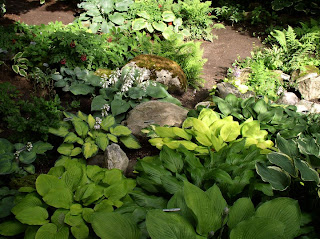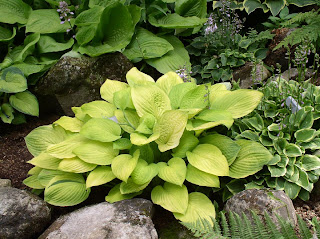
Thursday, February 25, 2010
A very weathery evening for me to be finishing up a series on planting a new hosta garden. Yesterday's +21" of wet snow gave us plenty of clean up work today. Gail and Alex worked much of the day while I was away and when I returned, I fired up the tractor and moved mountains of snow to more appropriate places. It was raining heavily when I came through Central Vermont but here on the mountain it was spitting snow even though the temperature was 36 degrees.
When I finally parked the tractor there were a couple places on the roof that needed final cleaning and as I leaned against the roof rake to take a break, I noticed that my neighbor's helper was just beginning to clean his roof and Michelle up the road had already done hers. Getting "feet" of snow off the roof when heavy rains are a possibility is something that has to happen, like it or not.
I expected storm activity again but right now a front is moving in and the wind gusts are powerful bursts of 13 to 19 mph and they continue to rise. We figure the electricity will go out before the night is over as the western slopes of our famous Green Mountains are expected to feel winds with gusts to 65 mph. We won't see those numbers but it will be gusty enough to take down trees that are dead or burdened by heavy snow loads. This isn't climate change, this is climate in Vermont.
When I finally parked the tractor there were a couple places on the roof that needed final cleaning and as I leaned against the roof rake to take a break, I noticed that my neighbor's helper was just beginning to clean his roof and Michelle up the road had already done hers. Getting "feet" of snow off the roof when heavy rains are a possibility is something that has to happen, like it or not.
I expected storm activity again but right now a front is moving in and the wind gusts are powerful bursts of 13 to 19 mph and they continue to rise. We figure the electricity will go out before the night is over as the western slopes of our famous Green Mountains are expected to feel winds with gusts to 65 mph. We won't see those numbers but it will be gusty enough to take down trees that are dead or burdened by heavy snow loads. This isn't climate change, this is climate in Vermont.
 The new hosta garden took longer than I thought to get to this point in its new history. Although there are somewhere around 150 varieties planted so far, I have divided up many clumps and split them up here and there. My plan is to have a nice looking garden in a couple years. In the interim I want be able to dig and sell larger hostas from the garden instead of relying on our potted selection. We have about 2500 potted in four and 6 quart pots but some of what I replanted are much bigger plants and they will do better in the ground.
The new hosta garden took longer than I thought to get to this point in its new history. Although there are somewhere around 150 varieties planted so far, I have divided up many clumps and split them up here and there. My plan is to have a nice looking garden in a couple years. In the interim I want be able to dig and sell larger hostas from the garden instead of relying on our potted selection. We have about 2500 potted in four and 6 quart pots but some of what I replanted are much bigger plants and they will do better in the ground.
If you look in the center of this picture (just above) you'll notice a row that is slightly wider compared to the widths the hostas are spaced at. This is intended to be the walkway. Sometime this late spring when the land dries a bit, I'll roll commercial road makers fabric down this path and then cover with some form of crushed gravel or slate. I want pathways that are easy to walk on but are also prominent enough to mentally hold visitors on the path. Each time I have gone to Maine Coastal Botanical Gardens I have wanted to yell at people who walk right into the middle of gardens to take pictures or read tags. I guess this "unpermissioned meandering" has to be expected if you offer a public garden but I don't care for it. When I was a child, the do's and don'ts of being polite and respectful of other peoples' property were lessons well taught but my practice and other folk's behaviors don't always match.
 The raised walkway that was a road in bygone years will offer visitors a chance to look down on the gardens from perhaps 7-8 feet above them . In time as the hostas mature and crowd together, it should be an interesting sight and should afford unusual photographic opportunities. The colors, sizes and textures of the hosta leaves entice some to break out cameras and take pictures. I hope in time the native plants and the complimentary ones we plant will help to brand Vermont Flower Farm as a convenient place to stop and see some Vermont hardy shade plants.
The raised walkway that was a road in bygone years will offer visitors a chance to look down on the gardens from perhaps 7-8 feet above them . In time as the hostas mature and crowd together, it should be an interesting sight and should afford unusual photographic opportunities. The colors, sizes and textures of the hosta leaves entice some to break out cameras and take pictures. I hope in time the native plants and the complimentary ones we plant will help to brand Vermont Flower Farm as a convenient place to stop and see some Vermont hardy shade plants. I am not pleased that the predominant trees are boxelders (no space, friends) but they are native to the adjacent Winooski River stream banks and fields. They are actually members of the maple family but they lack the strength and desirability of our state tree, the sugar maple, and are much weaker than even the red maples. As such I have planted some lindens, three varieties of maple, some weeping larches and some blue cedars. I'll add more conifers this spring.
I am not pleased that the predominant trees are boxelders (no space, friends) but they are native to the adjacent Winooski River stream banks and fields. They are actually members of the maple family but they lack the strength and desirability of our state tree, the sugar maple, and are much weaker than even the red maples. As such I have planted some lindens, three varieties of maple, some weeping larches and some blue cedars. I'll add more conifers this spring. It's a hike up and down the hill from the parking lot and I expect this will deter some visitors from making the journey. Everyone with bottomless pockets advises me to buy refurbished golf carts or ATVs and offer rides to older folks. Actually younger visitors are more in need of a ride than most seniors. I'm getting to be an "older folk" and if I wanted to offer rides I'd have to be prepared to give up everything else I do. Maybe in years to come when I can't garden as much I'll want to ride and talk more but for right now, no carts. For me there is something special about being able to visit a garden and not be rushed. I hope visitors will agree with me and want to spend time.
It's a hike up and down the hill from the parking lot and I expect this will deter some visitors from making the journey. Everyone with bottomless pockets advises me to buy refurbished golf carts or ATVs and offer rides to older folks. Actually younger visitors are more in need of a ride than most seniors. I'm getting to be an "older folk" and if I wanted to offer rides I'd have to be prepared to give up everything else I do. Maybe in years to come when I can't garden as much I'll want to ride and talk more but for right now, no carts. For me there is something special about being able to visit a garden and not be rushed. I hope visitors will agree with me and want to spend time. Since I planted this garden to the point it is, I covered the entire property with recycled burlap bags. My plan is to cover the bags with shredded leaves and tree chip mulch to keep down weeds and conserve water. Over time as the hostas and other plants mature, the mulch will be less noticeable and hopefully the plants will begin to hide them. I have used burlap bags before and expect similar success.
Since I planted this garden to the point it is, I covered the entire property with recycled burlap bags. My plan is to cover the bags with shredded leaves and tree chip mulch to keep down weeds and conserve water. Over time as the hostas and other plants mature, the mulch will be less noticeable and hopefully the plants will begin to hide them. I have used burlap bags before and expect similar success.When you visit Vermont Flower Farm, squeeze in some extra time to walk down the hill. If your visit is during a rainy day, week, month--we experienced all those last year--bring suitable footwear so you don't go sliding down the hill. This might be called a garden in motion as it is growing all the time. Come visit!
Writing from the mountain above Peacham Pond where the snowy road has turned to muddy tracks, wind gusts continue and the temperature holds at 33.8 degrees.
George Africa
The Vermont Gardener
Vermont Flower Farm
http://vermontflowerfarm.com
http://www.facebook.com/george.africa
Vermont Flower Farm and Gardens--new fan page on Facebook
http://www.twitter.com/vtflowerfarm













































